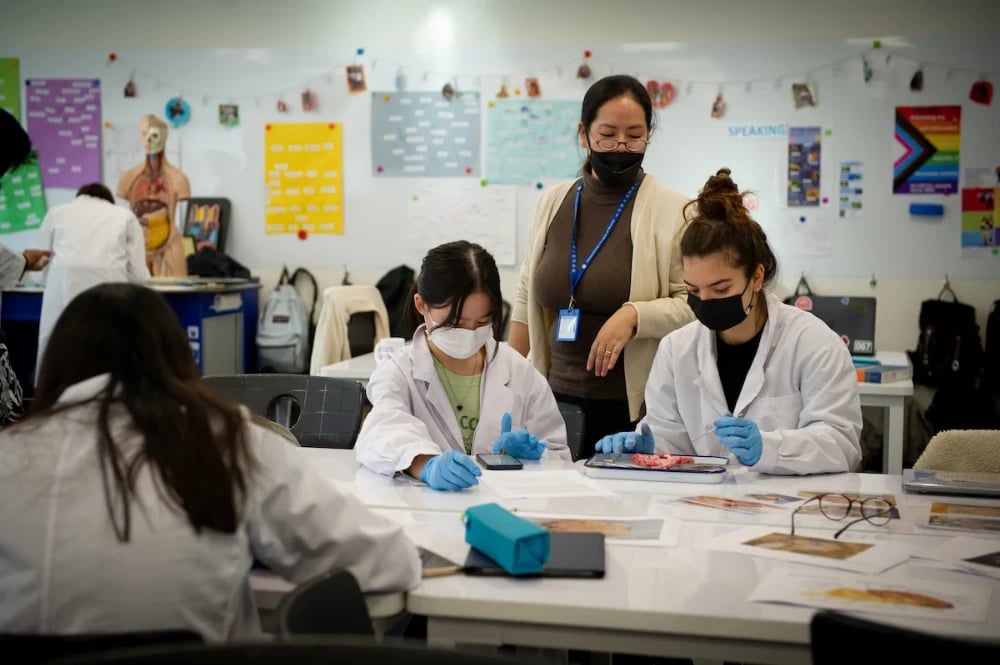Who’s the better teacher, Sage on the Stage or Guide on the Side?
By Jon Hill, Middle School Principal, with editing by Nick Yates, ISB Communications
The International School of Beijing’s (ISB) latest coffee mornings with the principals last week were, once again, a good opportunity to explain our carefully thought-out approach to education. This modern approach, backed up by a lot of research (like this and this), is proven to result in the most effective student learning and the best academic results.
Middle School parents often ask me about the mismatch between what we do in our classrooms at ISB and what they think we should be doing in our classrooms. The gap is the result of over two decades of shifting practices in education. As professional educators, what we know now about how best to teach is very different to what teachers in the 1970s, 1980s, and even 1990s knew. This means that good teaching today is far removed from what the parents of our students would have experienced at school.

Often, parents imagine that our classes should look like the classes they had as students. At ISB, we believe it is important to engage parents and explain what we are doing as a school through occasions like last week’s Parent Coffees or our Parent Education Series of talks and workshops.
Adults who have not had the benefit of such an explanation might be dismayed when they hear their child say that their teacher rarely directly answers a question, but instead asks questions back and lets the student find the answer independently. Does this mean that the teacher does not know the answer and is therefore unqualified?
Or they might be surprised at the use of free, independent reading, where students select books that interest them and keep journals about what they have learned through the reading. Is this a waste of class time?
Sage on the Stage versus Guide on the Side
The teacher who uses practices like these is often called “the Guide on the Side.” They implement student-centered learning in which the student has agency and is made to think rather than memorize. The opposite is the “Sage on the Stage,” who stands at the front of the classroom and imparts knowledge to remember.
There remain occasions where it’s appropriate for the teacher to act as the Sage on the Stage. Both styles of teaching, if done well, have their place. There is consensus that what matters is raising student engagement.

In the case of the Guide on the Side, they create a structured environment for students to learn on their own. Rather than learning through the narrow scope of the demonstrations and examples given by the teacher, class members are getting something much more personalized.
For example, following an introduction from the teacher on a particular topic, the student may be free to choose their own book to study from a selection on that topic. They might read on their own during class time, or form into groups with other students to discuss the book. Meanwhile, the teacher will circulate round the classroom and give prompts or ask questions.
In such a model, the student understands that what the teacher has introduced is broadly applicable, and they’re going to get a chance to apply it in a book that’s customized to their level or their interests. They therefore own the process of learning themselves, and their engagement is a lot higher. And through group work, students are practicing “soft skills” like collaboration.
Strong relationships for the best learning
It takes a skillful teacher to be a Guide on the Side. It’s much easier for the Sage on the Stage to stand at the front and manage a silent class sitting in formation. The Guide on the Side must set expectations and build trusting relationships with their students, so that students understand the value of 20 minutes of independent reading time and know what to do with it.
There has been a lot of study, peaking over the last few decades, about how the mind works and how students learn most effectively. Conscientious teachers like those at ISB have considered the principles and worked out how to best apply them.
Looking at everything from styles of teaching to a student’s home life, celebrated professor of education John Hattie has produced a comprehensive list of influences related to learning outcomes, ranking them from those with very positive effects to those with very negative effects. When it comes to styles of teaching, student-centered approaches to learning, those associated with the Guide on the Side, are clustered at the top of Hattie’s ranking.
That is why ISB teachers tend to be Guides on the Side. Members of the ISB community can find the presentation from last week’s Middle School Principal Coffee, in which I talked more about these issues, here. We’re committed to challenging and joyful learning with students and communicating our principles to the wider community.
ISB is an extraordinary school, made so by a tradition of educational excellence spanning 45 years. Establishing, nurturing, and growing such an exceptional learning community has been and remains intentional; we work hard to build strong relationships so our learning is at its best.
